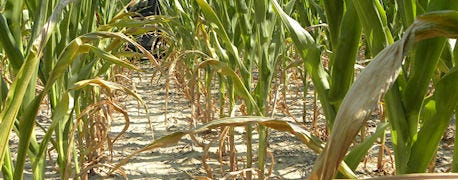July 5, 2012

By Marilyn Thelen
June 2012 turned hot and dry in Michigan and few farmers are getting relief from the scattered showers. These conditions have led to moisture stress in corn. When this occurs for a prolonged number of days corn yield can be impacted. This article, updated from one written by Dr. Kurt Thelen, MSU, Department of Crops and Soil Sciences, provides an understanding of how drought stress impacts a plant at various stages of development.

Effects Of Drought-Stress On The Corn Plant
Inadequate moisture during any period of growth can result in reduced grain yield. Nutrient availability, uptake and transport are impaired without sufficient water. Severe moisture stress is indicated by leaf wilting that is alleviated only when plans receive additional water.
Comparing the stage of development of corn and the days of visible moisture stress can provide an estimate of potential yield loss. As of June 28, corn development in Michigan ranged from V5 to V12 (Regional reports on Michigan field crops – June 28, 2012).
Four consecutive days of visible wilting can reduce potential corn yield by 5 to 10% during the vegetative growth stage. Drought stress prior to tassel and silk appearance may result in small ear size. From approximately the 8-leaf to the 12-leaf stage (V8 to V12), potential kernel row number is determined in the corn plant. From the 12-leaf to the 17-leaf stage (V12 to V17), potential kernel number per row is determined. Moisture stress during the vegetative periods may reduce both ear length and the number of potential kernels on each ear. If ear size is reduced during this period, it cannot be corrected by relieving the moisture stress later in the season.
During silking and pollination, yield reduction after four consecutive days of wilting can be as much as 40 to 50% (see Table 1). Moisture stress during this period can result in a lack of synchronization between pollen shed and silking at pollination, because pollen grains may not remain viable and silking may be delayed. If a plant has tasseled and shed pollen but no blisters have appeared, it will be barren. A common result of prolonged moisture stress or moderate moisture stress during late pollination is the production of ears with barren tips. This occurs because the tip kernels were not pollinated or were aborted after pollination.
In order to determine harvest options for drought stressed corn, an assessment on potential grain yield should be conducted. Within one to three days after a silk is pollinated and fertilization is successful, the silk will detach from the developing kernel. Thus, you can carefully remove the husk leaves from an ear shoot, shake the cob, and estimate the degree of successful fertilization by observing how many silks shake loose from the cob.
Table 1. Effect of drought on corn yield
Stage of development | Percent yield reduction |
Early vegetative | 5-10 |
Tassel emergence | 10-25 |
Silk emergence, pollen shedding | 40-50 |
Blister | 30-40 |
Dough | 20-30 |
Classen, M.M., and R.H. Shaw. 1970. Water deficit effects on corn. II. Grain components. Agron. J. 62:652 |
Another method to determine whether drought-stressed corn plants have been pollinated and fertilized is to look for small white blisters on the ear seven to ten days after pollen shed. To identify the blisters, take ears from several areas in the field and break them in half. Using a knife, dig out several kernels on each ear. If you find kernels that resemble blisters on the ears, you can assume that kernel fertilization occurred. If you are unsure whether fertilization has occurred, observe the kernels again in five to seven days. If the kernels were fertilized, the blisters will have rapidly increased in size. If fertilization did not occur, the kernels will not have increased in size. It is also possible to tell if fertilization has occurred by slicing the kernels longitudinally through the embryo side and looking for the young embryo. Only fertilized kernels will produce embryos. Most kernels that have been fertilized will continue to develop and mature if the plants get water.
Drought stress after pollination and fertilization can result in aborted kernels or poor kernel fill, causing low test weight and reduced yield. It may also predispose the plants to development of stalk rots.
This article was published by MSU Extension. For more information, visit http://www.msue.msu.edu. To contact an expert in your area, visit http://expert.msue.msu.edu, or call 888-MSUE4MI
Thelen is an MSU Extension Educator
You May Also Like




